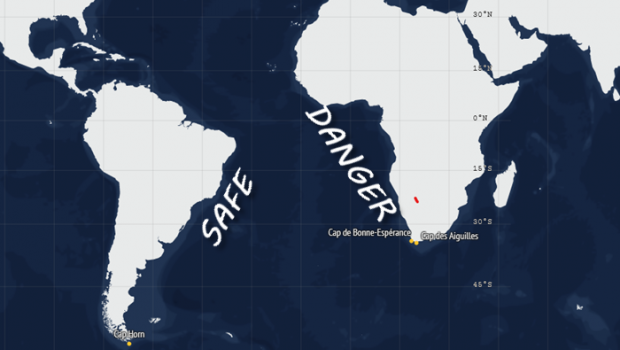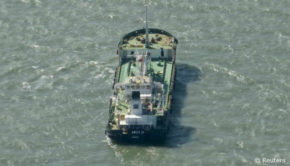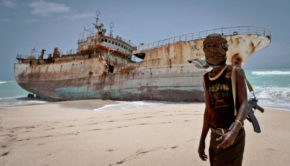Piracy problems along West Africa
Published on January 20th, 2021
When offshore races ascend or descend the Atlantic Ocean, crossing the equator, along with the notoriously difficult weather of the doldrums, dictate specific routing. When combined with the St. Helena High in the South Atlantic, the fastest routes are nearly always in the western section of the ocean.
Whether coming from Cape Horn to Europe, or leaving Europe for Cape Town, wind patterns have racers hugging South America, which is a blessing as West Africa continues to present piracy problem. Here’s an update from Lloyd’s List which provides maritime news:
The rate of piracy attacks has not changed significantly in recent years, despite what some misleading headlines may suggest.
The increasing volume of calls for international action to combat west Africa’s stubborn piracy threat has more to do with the changing nature, and financial impact, of the attacks — and the public profile of those being attacked.
Concerned shipowners demanding a response in the wake of worryingly predictable attacks are nothing new.
But when Denmark-based Maersk called for military action after two of its ships were targeted in close succession, it prompted a direct response from the Danish government.
That response comes with the promise of a new government-appointed special representative, more funds and the all-important political clout of an influential western government able to demand answers to questions that previously received apologetic shrugs of indifference.
The other major change in the equation is from the pirates themselves.
Pirates are attacking further from Nigeria’s shores, making attacks harder to predict and plan for. There are fears criminal gangs are getting more professional in how they take and hold crews for ransom.
The greater spread of attacks led the Joint War Committee of insurers in September to widen its Gulf of Guinea listed area further south and east, meaning insurers can charge more to cover ships there.
The volume of attacks is slightly up — or down, depending on who you ask — and the wider issue of unreliable piracy statistics makes for an opaque view of trends.
The International Maritime Bureau counted 130 crew kidnapped off West Africa last year, up slightly from 121 in 2019 and 78 the year before. More complete reporting may help explain the increase, but many attacks still go unreported.
Security sources take annual reports like the IMB’s with a grain of salt, since they do not count or classify incidents the same way, and can include attacks on fishing vessels or those related to local crime.
Confusing statistics also make it hard to tell if the problem is getting better or worse — a rise from 10 attacks to 14 can be trumpeted as a 40% rise in piracy.
One security adviser said while the statistics went up and down each year, the overall threat had changed little in the past decade. But all agree even one attack is too many.
“It is unacceptable in this day and age that seafarers cannot perform their jobs of ensuring a vital supply chain for this region without having to worry about the risk of piracy,” said Aslak Ross, head of marine standards at AP Moller-Maersk, following the attack on Maersk Cardiff (IMO: 9529255) off Bonny, Nigeria on January 13.
A month earlier the boxship Maersk Cadiz (IMO: 9526459) was also attacked, though no crew were harmed in either incident.
Mr Ross said effective military capacity was needed in the short term to protect ships. In the longer-term governments and other stakeholders had to step up efforts to counter the problem through strengthened legislation.
Denmark’s move to appoint a special representative for maritime security and increase funding to security efforts is a notable step forward.
BIMCO head of maritime safety and security Jakob Larsen welcomed the news, adding that “relatively few” ships would be needed for this “simple maritime law enforcement operation”.
“Two frigates each with a helicopter and a robust antipiracy mandate, supported by a maritime patrol aircraft operating from an airport in the region, would constitute a potent deterrent,” he said.
“Furthermore, if local law enforcement teams were embarked to formally make the pirate arrests, the operation would have a clear regional fingerprint.”
The industry is also eager to see what difference Nigeria’s $195m Deep Blue antipiracy project, to better co-ordinate its navy and maritime authority NIMASA, will make this year.
BIMCO is also looking forward to the first trial to test Nigeria’s 2019 antipiracy law. The country’s unreliable justice system has meant pirates are not convicted even if they are caught.
But to have a chance of policing the threat, Nigeria must allow international navies to help patrol the region. Denmark has struggled to find volunteers to help answer its welcome calls for action, though it is early days.
Ultimately, the region’s deeper problems — widespread poverty, high youth unemployment, and weak and corrupt state institutions —mean the economic motive to attack ships is unlikely to change any time soon.
And the industry cannot resort to private armed guards, like it did in Somalia, since Gulf of Guinea states mostly forbid them.
That means shipowners and operators must stick to Best Management Practices West Africa to prepare ships and train crews. Doing so will not stop a ship being boarded — but it could make all the difference to the crew’s safety.
“Operators should take action themselves by ensuring their vessels and crew are hardened and trained with layered defence measures to deter, detect, delay and deny piracy,” said Control Risks senior maritime analyst Cormac McGarry. “When implemented effectively this approach will protect mariners.”
Meanwhile, shipping also continues to face security threats in the Singapore Straits, with 97 incidents of piracy and armed robbery in 2020, according to the region’s piracy watchdog ReCAAP. Most of these attacks are nonviolent petty thefts, but crew have been injured in the past.
And in the Middle East, ships have risked fallout from the proxy conflict between Iran, Saudi Arabia and other state powers.
None more so than the 20 crew of South Korea’s chemical and oil tanker Hankuk Chemi (IMO: 9232369), who remain detained two weeks after Iran’s revolutionary guards seized the vessel over alleged pollution — but more likely over a fight with South Korea over sanctioned oil funds.
Yemen’s Houthi rebels have laid sea mines in the Red Sea, prompting murmurs about insurance rate rises. But security experts say the Trump administration’s branding of the Houthis this week as a terrorist organization will leave its waters, and Yemen’s starving people, worse off.
For the latest piracy incidents, see our Casualties page or subscribe to the Lloyd’s List Intelligence Casualty Reporting service for real-time alerts.









 We’ll keep your information safe.
We’ll keep your information safe.